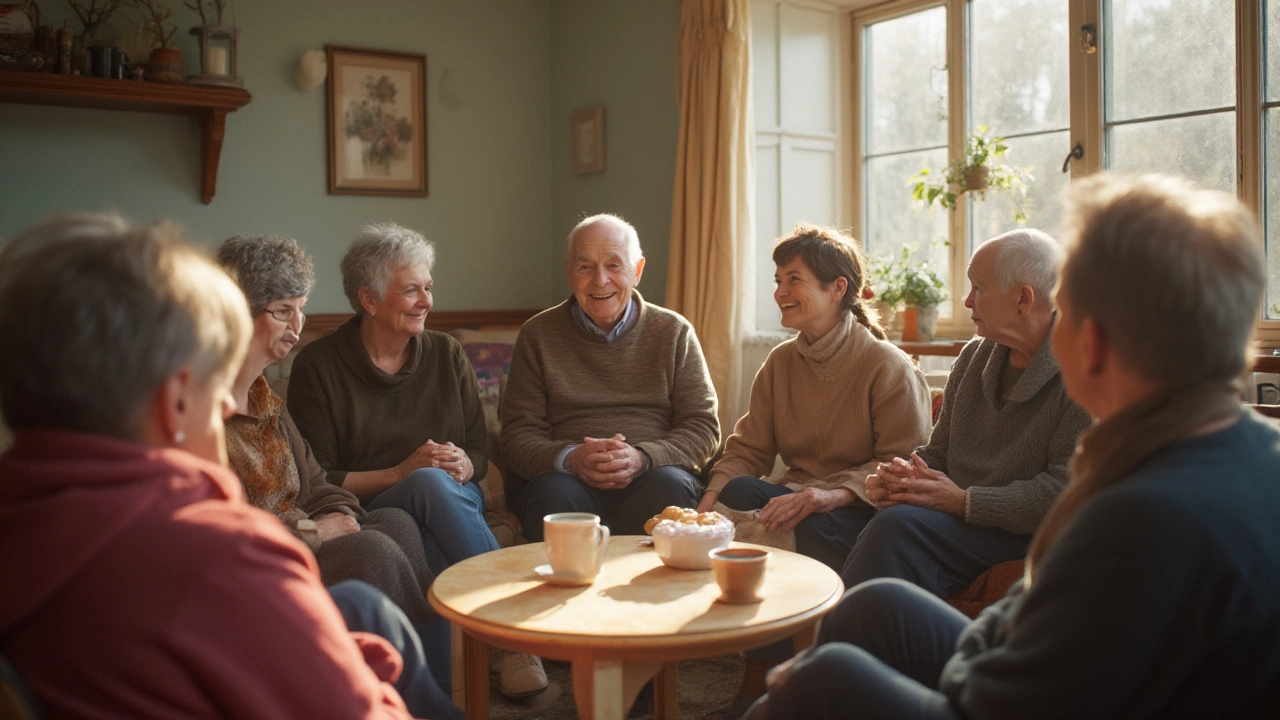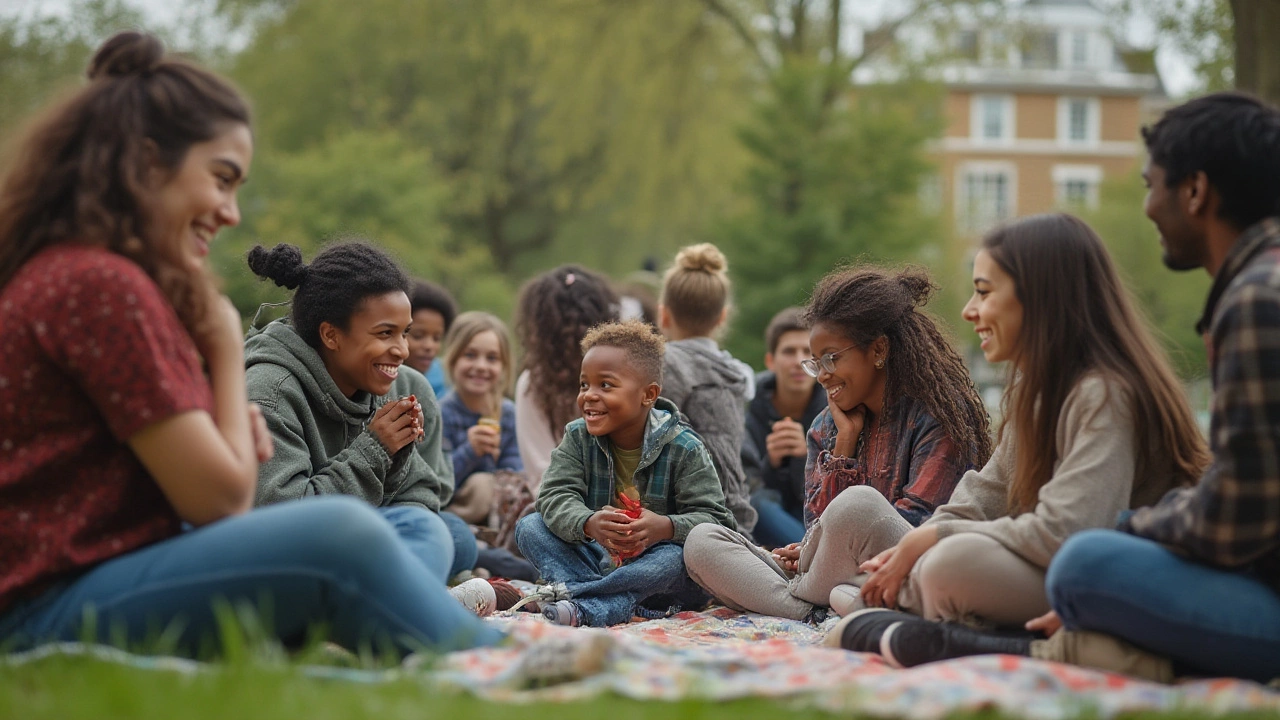Support Group Examples: What Makes a Real Support Network?
 Jul, 19 2025
Jul, 19 2025
You’d be surprised how many people feel like nobody else gets it—whether that “it” is grief, addiction, new motherhood, divorce, anxiety, or caring for someone with a chronic illness. Here’s the twist: across the world, millions actually gather every week to help each other survive life’s hardest, weirdest, or loneliest days. That’s exactly what a real support group offers. If you picture plastic chairs in a chilly church basement and a pot of weak coffee, you’re not totally wrong—but there’s so much more happening. Support groups have quietly changed how communities face adversity, build resilience, and stop isolation in its tracks.
What Exactly Is a Support Group?
Let’s clear up the biggest mix-up: a support group isn’t just any club or community event. It’s a gathering—face-to-face or online—where people with a shared experience come together so nobody has to go through hard things alone. You might have heard of famous ones, like Alcoholics Anonymous (AA), which began in the 1930s and uses its well-known “twelve-step” program to guide folks through recovery. But there’s a group for just about everything. People with depression meet in living rooms or Zoom rooms to talk about the lows they can’t explain to coworkers. Parents of kids with autism swap resources, discuss therapies, and comfort each other when the school system feels overwhelming. Cancer survivors run monthly walks, hold hands at doctor’s visits, and crack the kind of jokes nobody else would get.
The defining trait? Real support. Members aren’t paid therapists—though a professional might lead the group sometimes. Instead, every conversation between equals is about “me too” instead of “you should.” That’s why peer-led groups, like the National Alliance on Mental Illness (NAMI) or GriefShare, work so well. The relief, just to be in a room where you don’t have to fake it, is huge. Studies from Yale and Harvard have shown that people in support groups often stick to treatment plans better, recover quicker, and feel less alone. The American Psychological Association points out that folks in breast cancer support circles are less likely to develop depression or drop out of therapy. That’s not just coincidence—connection, it seems, packs more power than a prescription.
Not all groups are created equal, though. If a “support” group feels like a lecture or makes people feel judged, it doesn’t work. The hallmark is shared storytelling (and honest listening). Ever walked in silent already feeling lighter, knowing nobody will say, “it could be worse”? That’s the magic. It’s also true that not every group is right for every person. There are closed groups for confidentiality, open groups where anyone can show up, online-only setups, and even texting collectives like 7 Cups (which uses trained listeners and anonymous chats). In short, if it involves mutual help, belonging, and empathy based on real experience, it’s probably a support group.

Types of Support Groups and How They’re Structured
Support groups come in more shapes than you might think. People often imagine therapy-style circles and confessionals, but the forms have expanded, especially post-pandemic. There are in-person, virtual, phone-based, and even text-based support collectives, some with professional facilitation and others that are fully peer-run.
Peer-led groups usually start with someone who’s “been there” organizing a meeting. Take, for example, Mothers Against Drunk Driving (MADD), founded in 1980 by a mother whose child was killed by a drunk driver. She wanted company in her grief—and her organized kitchen table meetings became a nationwide support network. Now, MADD offers both advocacy and a shoulder to cry on for victims. Or look at SMART Recovery, which spun off from traditional AA to offer a secular, science-based program for overcoming addiction, with daily online meetings where nobody lectures and everyone brainstorms practical tools for managing cravings.
- Mental Health Support Groups: These tackle depression, anxiety, PTSD, bipolar disorder, and more. You’ll see groups led by therapists or by survivors themselves (like Anxiety and Depression Association of America’s support forums).
- Medical Diagnosis Groups: From the American Cancer Society’s serious yet hopeful meetups to diabetes-specific collectives like JDRF for Type 1 families, these groups deliver survival strategies and a sense that you’re not a statistic—you’re seen.
- Life Transition Support: New parents (think La Leche League), recent widows, divorcees, empty-nesters, and teens navigating gender identity—all these situations inspire thriving support movements. The rules, agenda, and tone of meetings change based on the group’s purpose: comfort, education, activism, or all three.
- Online-Only Groups: With platforms like Reddit’s r/stopdrinking, Discord servers for trans youth, and forums like PatientsLikeMe, the definition of “group” has exploded. Distance and stigma are no longer roadblocks.
Good support groups usually share a few qualities. They’re confidential—what’s said stays in the group. Everybody gets time to talk. Respect is absolutely non-negotiable; interruptions, “should-ing,” or dismissing others’ pain are out. Often, meetings have a loose structure: check-ins, sharing, and either group problem-solving or just quiet validation. Some, like Family-to-Family (run by NAMI), use evidence-backed education modules, but participants still drive much of the discussion.
One interesting fact? Support groups have real staying power. The National Cancer Institute reports that some cancer support groups in the U.S. have lasted for thirty years or more. This isn’t just tradition; it’s because people keep coming back, finding new common ground as life changes. Many group members even turn mentor, helping newbies adjust after diagnosis, job loss, or grief, which research from Johns Hopkins has tied to lasting improvements in life satisfaction for both givers and receivers.
Ready to find your own people? Websites like Mental Health America, Meetup.com, and even Facebook host directories with hundreds of niche support groups, from chronic migraine warriors to survivors of childhood trauma. Just check that a group is run by a legitimate organization or leader—especially if it asks for fees. Look for testimonials, clear ground rules, and a privacy policy. If a group is what it says it is, the first meeting won’t feel intimidating. You’ll know you’re in the right place when honesty feels easy, and you’re not the only one with tissues in your pocket.

How Do Support Groups Make a Difference?
Plenty of people wonder: what do you actually get out of joining a support group? Isn’t “talking about it” just wallowing, or worse, unproductive? Research and real-world stories both shout “No.” There’s a reason support groups have exploded in popularity—by 2021, over 3.5 million Americans joined at least one, with the number rising every year, especially after COVID-19 isolated so many.
First, support groups deliver practical advice. Say you have just been diagnosed with multiple sclerosis. Textbooks can’t tell you which brands make the best mobility aids, but a group member can. If you’re fighting relapse cravings after addiction, only someone a few years ahead can share the shortcuts (and honest failures) that made recovery stick. Parents coping with childhood loss or miscarriage aren’t just handing out platitudes—they’re sharing what it felt like to plan a new holiday, or how they managed to mark birthdays in healing ways. This isn’t theory; it’s lived and field-tested advice, often more comforting than any pamphlet.
Emotional validation is priceless. The Cleveland Clinic found that 71% of people in group therapy or peer support reported lower rates of depression and anxiety after just three months. Why? Because social belonging is a literal tonic—your body responds when you feel seen. Cortisol (the stress hormone) drops, and oxytocin (the bonding hormone) rises. People sleep better, face less burnout, and even—according to a University of Michigan study—heal from surgery faster if they’ve got a support network.
Support groups aren’t all hugs and hand-holding, though. The best ones challenge unhelpful thinking, call out self-blame, and nudge people to try things again. That could mean setting gentle goals—calling a creditor despite the shame of bankruptcy, leaving the house after a panic attack, or even just going to a support group at all. Accountability happens, but it doesn’t feel like policing. And let’s face it, hope is contagious. Watching a survivor rebuild after a bad breakup or someone in recovery hit six months sober reminds the group that change is possible. Even if their styles of coping, humor, or faith differ, participants leave with new ideas and actual, practical energy.
There’s also a surprisingly concrete ripple effect: communities with thriving support groups (look at urban Seattle or rural Minnesota counties with robust grief and recovery circles) see lower ER visits for mental health and fewer relapses after treatment. Hospitals and clinics now partner with peer-run networks to keep people from falling through the cracks post-discharge. Employers are getting in on the action—tech companies and banks now run stress and burnout circles for anxious employees, which lowers turnover and sick days. Plus, teens and young adults who join LGBTQIA+ support spaces report less bullying trauma and fewer symptoms of anxiety and dysphoria.
So how do you know if you need a support group? If you’re stuck, lonely, or can’t shake a tough experience, your smartest move might just be to look for people walking the same road. Being heard—without judgment—isn’t just comforting, it’s critical. You might show up to a cancer support night exhausted and quiet, only to laugh unexpectedly at another member’s gallows humor. Even shy people often say the pure relief of belonging is what finally got them through. No magic wands, but in a world that can feel so disconnected, finding your circle might be as close as it gets.
